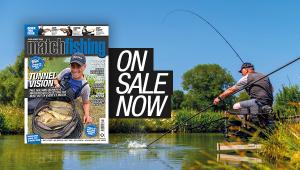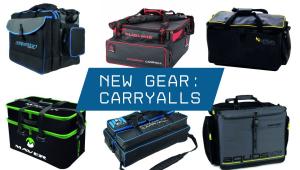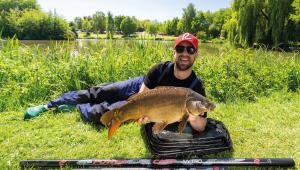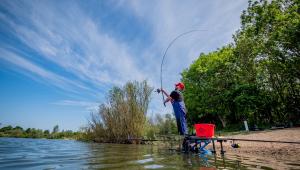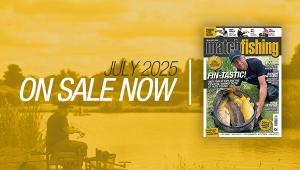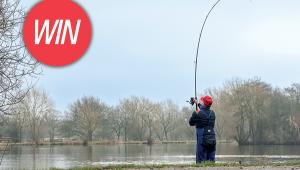The Method Feeder With Alan Scotthorne

Alan Scotthorne takes a closer look at one of the best fish catchers on the planet. Here’s a five-time world champion’s take on the Method feeder!
Feeder fishing has really taken off over the last few years and it’s not hard to see why. You can comfortably fish a feeder in practically any conditions you’re faced with. You’re giving the fish a concentrated pile of food on the bottom with a hook bait right next to it. It’s a positive approach and wins a lot of matches. It’s also not expensive to get yourself kitted out to compete on the same level as everyone else. There are now even feeder-only matches springing up all over the place; not just here in England but all across Europe.
There are loads of feeders to choose from so it’s just a matter of picking the right size and weight for the day depending on the conditions, the baits and the species you are targeting. Today I have come to Barston Lakes in the Midlands to show you one feeder technique in particular and that’s the Method. Where allowed, it’s the deadliest way to catch carp on the tip. It’s, therefore, a key technique we all must try to master. Here are a few pointers in getting the most out of this match winning method.
Top Tip – Boom
I always twizzle the last 12 to 15 inches of my main line to create a doubled-up boom. This is the area that gets the most punishment, both in the lake and when a fish is in the landing net, so it makes sense to double it up.
Where To Fish
There are different types of venues in England, from narrow snake lakes to large, open and exposed waters like this one. Each presents a slightly different challenge but the basics are always the same. Here, it is very wide but also relatively shallow, with around 4ft all over so there are no deeper holes or drop-offs to worry about. When this is the case it’s the distance you fish that can be the most important consideration. In match conditions, you will probably have everyone in a row casting out into the middle of the lake so it’s important to try and find yourself your own bit of water. Sometimes that will mean casting further than those around you; sometimes you might be better off starting much shorter. I know this lake is dominated quite a lot by distance fishing and a 50 to 70-metre cast can be commonplace.
The wind can play a large part too. A strong head wind will seriously hinder your casting potential. Today I have a tricky headwind but I have deliberately chosen to start at 70 metres to give my Acolyte Plus 12ft Feeder rods a really good flexing. In a match, I would probably have started at 60 metres, to begin with, and see how things progress. I have actually clipped up at this range too and use some Cygnet Distance Sticks to measure the exact range, so I know exactly how far I’m chucking. These sticks aren’t essential but they are a useful aid if you are feeder fishing a lot and also want to have two rods clipped up at exactly the same distance. They are a more accurate alternative to counting the number of turns on your reel.
Another big consideration is the number of specimen carp anglers that visit your lake. Barston sees as many specimen anglers as it does match anglers and these guys like to cast big leads a long way. They also regularly use spods, throwing sticks and bait boats to get plenty of bait out into the middle of the lake. The more pressure a lake gets from carpers the more that will affect the behaviour of the fish. They know where all the high-protein bait gets fed and match anglers need to pay attention to this.
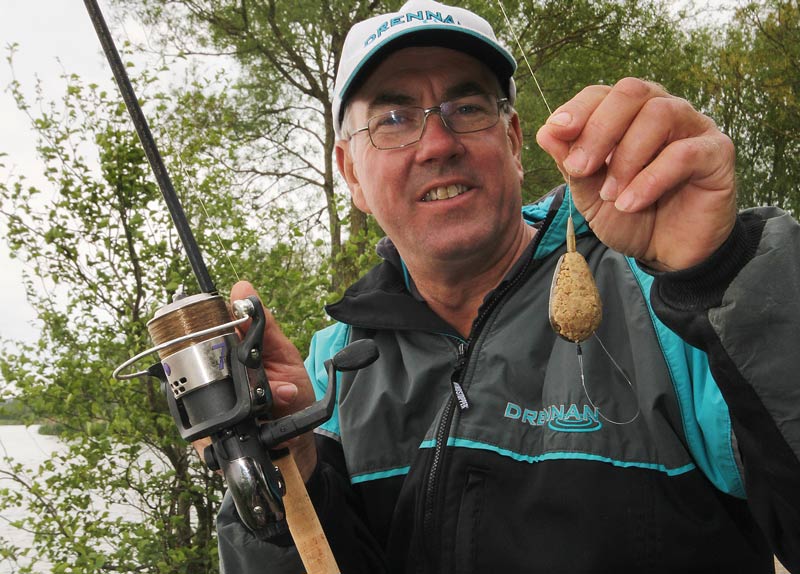
The best angler in the world with one of the world's best fish-catching methods. A deadly combination!
Clip Up Or Not?
To begin with, I like to maintain a fixed feed area in my peg. Later on, you can try unclipping to search further and shorter – or better still have a second ‘roving’ rod set up for this purpose. Feeder fishing is no different to any other method and a slow build up of bait in a specific area will often lead to the peg getting better and better. Often the last hour is when it will really kick in.
By clipping up at a set range you also establish an area of undisturbed water beyond this where you can try casting later on.
Another good reason why I like to clip up is to ensure the feeder lands properly. Several times today I haven’t quite hit my line clip and could instantly tell by the noise the feeder made on impact. When this happens I won’t hesitate to reel in, rebait and recast. When I am waiting up to 10 minutes for a bite I want to be certain the feeder has gone in right, with the feed still intact. I cast quite hard to ensure I hit the clip and then bring my rod sharply back just before it reaches the distance. This straightens the line and also acts as a brake, effectively slowing it down and reducing the feeder’s impact. You are aiming for a reassuring plop rather than a great big spladoosh!

Alan uses a free-spool reel when Method-feeder fishing
Gearing Up
It’s important to tailor the rod to the distance you are fishing. My rod for today is a 12ft Acolyte Plus as I’m fishing a long way out. At this kind of range, you have to reach a good compromise. You want enough backbone lower down for casting but still some forgiveness in the top section for playing carp, F1s and skimmers. If I was fishing shorter I would use a 10ft or 11ft rod instead as shorter rods can have a more forgiving casting and playing action.
I’ve matched the rod to a Series 7 BR 9-40 reel which is a reliable workhorse model. This also has a freespool mechanism which I like to use when I’m not clipping up. I’ve loaded this up with Drennan Feeder & Method Mono. You want something that’s strong, hardwearing and sinks well. I am using 6lb today which is a great all-round choice. If I was specifically targeting big carp closer in then I might use 8lb.
However, 6lb is thinner and casts much further. To achieve even greater distances I will use 5lb line combined with an 8lb shock leader. The shock leader is necessary to take all the pressure on the cast.

Barston is renowned for its lumps and thet're suckers for a Method attack
The Feeder
I prefer to use Drennan In-Line Flatbed Method Feeders which are of a good, strong and robust design that casts ever so well. The 25g model sees the most use and is always my choice when I am casting to an island as the weight grips well on a steep slope. However, I am using a heavier 35g today purely to reach the distance.
I have also gone for the larger frame size as the main target are big carp so I prefer to give them a reasonable amount of bait to home in on. If I was targeting smaller carp and F1s and was casting much more frequently then I wouldn’t hesitate to use the smaller frame size instead. In general though, for open water and when I expect to wait longer for bites I prefer to use a larger feeder.
Incidentally, when these feeders first came out I was never convinced they could land the right way up all of the time. It was only after lots of experimenting with countless casts on a gin-clear lake that I was completely satisfied. Every single time these feeders settled the right way and I have never doubted them ever since!
End Tackle
My hooklength is 0.18mm Supplex which is strong enough for double-figure carp but also acceptable for the F1s in this lake of which there are plenty. Around four inches is the usual length for a Method feeder hooklength but this is something the fish must be very used to. For this reason I also experiment with slightly longer five inch versions and this has worked quite well today. It’s worth experimenting as sometimes going shorter or longer than the norm can make a difference.
To attach my hooklength I use a Cralusso Quick Snap Swivel combined with a medium Drennan Swivel Stop Bead. The hook is a prototype pattern I’ve been field-testing in sizes 12 and 14.
The Feed
There are three main choices when it comes to what you mould around the feeder; groundbait, pellets or a mixture of the two. Some venues will show a marked preference but again it’s worth experimenting. My groundbait is Sensas Stimul-8 with some extra crushed marine pellet and fishmeal added. I like quite a strong mix for maximum attraction. The pellets are wetted enough so that they cling around the feeder well but quickly break down once the feeder hits the bottom. I use mostly 2mm micro pellets but also add some 4mms to vary the particle size. A couple of bowls on my side tray mean I can easily vary the ratio of pellets and groundbait as I see fit.
You can also vary the actual volume of bait you mould around the Method and on a place like this I am a big fan of ‘double skinning’. That simply means forming your feed around the Method feeder as normal with the help of a mould, then adding a little bit more feed to the mould and forming a second layer on top.
Hook Baits
In no particular order, my top Method feeder hook baits are boilies, hard pellets, punched meat and dead maggots. Again, these will vary depending on what’s happening in the swim. Boilies and hard pellets are much more resilient if small fish are a problem but meat and maggots are softer, lighter and less likely to be rejected.
Today a pink Crab & Krill Bandit Dumbell boilie has easily been best, but I have also had fish on an 8mm piece of punched meat and a couple of big F1s on a bunch of dead maggots. It definitely seemed like the fish preferred a bold, contrasting hook bait today though, especially the bigger ones, including an immaculate looking linear mirror that must be at least 15lb. It doesn’t take many fish like that to build a winning weight and that’s why the Method Feeder should never be ignored!
Top Tip – Hard Pellets
Try adding some dry pellets to your wetted 2mm and 4mm feed pellets. This is a good trick when there are lots of silver fish about and also makes sense if you are fishing with a hard pellet on the hook.
Top Tip – Boilie Boost
This venue sees a lot of specimen carp anglers who feed lots of boilies, so I like to add a sprinkling of white shellfish boilies that have been ground down in a blender. Where allowed they can give your mix an extra boost of attraction.
Top Tip – Boom
I always twizzle the last 12 to 15 inches of my main line to create a doubled-up boom. This is the area that gets the most punishment, both in the lake and when a fish is in the landing net, so it makes sense to double it up.
Top Tip – Hands Free
Always use front and rear rod rests with the Method. This ensures your hands are free to do other jobs, but make sure the front rest is a design that won’t allow the rod to get ripped off and dragged into the lake on the take!
(panel)
Venue File
Barston Lakes
Tel: 01675 444890
Marsh House Farm Lane, Barston, Solihull, West Midlands B92 0LB
www.barstonlakes.co.uk
- Log in or register to post comments
